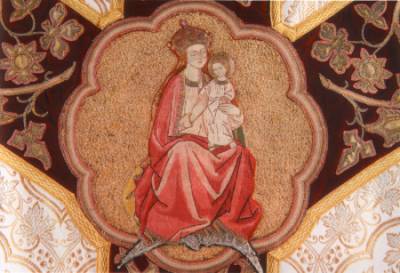| |
Each workshop was the
responsibility of a directress who was responsible for
the planning of operations and for the training of the
embroideresses. Wheras the gifted embroideresses
performed the demanding embroidery of figures, less
talented sisters or orphans, who were in the care of the
Congregation's charitable institutions, were responsible
for the easy tasks. A few exceptional embroideresses have
come down to us in written sources. The practical
training of the embroideresses was effected according to
medieval standards. All works being hand-made, the time
expended for the production of ecclesiastical ornaments
and vestments was relatively significant, which
inevitably had consequences for prices. The high prices
were also due to the valuable material, which was
obtained only from the most renowned firms.
The main customer was the Catholic Church, whose
position had strengthened again in the second half of the
19th century, especially in the Rhinelands. Orders came
from parishes, religious orders, congregations and
seminaries from all over Germany and from abroad.
Important customers were also the Rhenish and Westphalian
aristocracy and the bourgeoisie that became wealthy in
the 19th century, as well as Catholic societies and
brotherhoods that were founded in great number at that
time. Contact with clients was established by way of
personal relations or by means of the many exhibitions at
which the Sisters were represented with selected
ecclesiastical ornaments and vestments.
The embroidery of the Sisters of the Poor Infant Jesus
is characterised by a wealth of iconography with almost
exclusively religious content, which deliberately
continues traditional themes and motifs. In accordance
with the educational mission that sacred art aimed to
fulfil in historicism, the iconographic programmes are
carefully considered in theological respects, and they
are related thematically to both the liturgical function
of the ecclesiastical ornaments and vestments as well as
to Marian piety and the veneration of saints and the
Eucharist , which were revivied at that time.
Apart from the figurative representations, on most of
the ecclesiastical ornaments and vestments, there are
inscriptions that imitate - almost without exception -
Gothic minuscule and majuscule characters, and that
underline and specify the theological intention of the
iconographic programmes.
|


